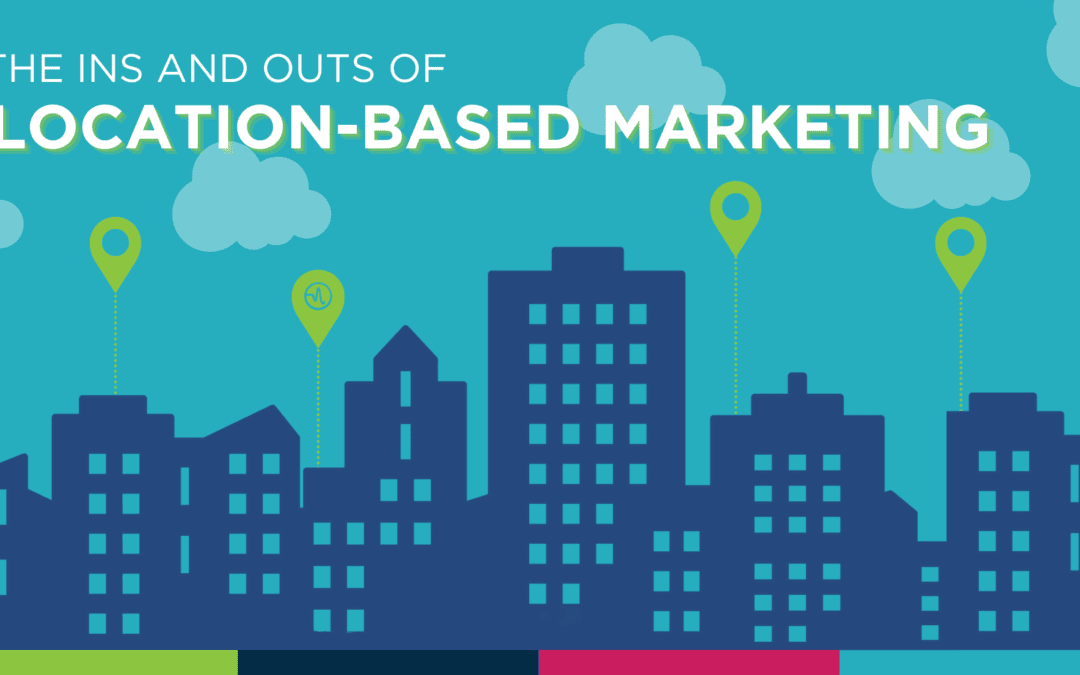Picture this – You’re walking through the mall scrolling through your Pinterest boards trying to find outfit inspo you pinned yesterday when you notice an ad for a store in the mall offering 50% off. You are most likely receiving this relevant content as part of a location-based marketing strategy. In other words, that brand is serving you a message based on data about your physical location.
The Lingo
There are several different names to describe the use of location-based data in marketing that all mean the same thing: location-based marketing, geotargeting, proximity-based marketing, etc. Here are few other keywords used in this type of digital marketing:
Real Time/Hyperlocal – targeting a user based on their current location.
Lookback – targeting a user based on their past location. Usually able to do so within one year of the location visit.
Geofencing – the creation of a boundary so that when a person enters the area or radius of the boundary they become an active target of the brand’s marketing strategy.
Geo Conquesting – a marketing strategy designed to divert competitor’s foot traffic by offering them a better deal when they are in or near a competitor’s location.
IP Targeting – using an Internet Protocol (IP) Address (a unique numerical code that is associated with each unique device on an internet network) to target people using devices connected to the WiFi network at that physical location which can be either residential or commercial.
Weather Targeting – targeting users in an area based on prevailing or upcoming weather conditions to serve relevant marketing messages.
Advantages
As of April 2020, 81% of US residents own a smartphone and for 37% of those users it is their only means of accessing the internet. The majority of smartphone users take their device with them wherever they go. This provides businesses a way to bridge the gap between online and offline behaviors to attain valuable insights into the best ways to tailor their messages to be more effective.
Another reason location-based marketing is beneficial is an improved customer experience as it is personal and timely. Consumers are bombarded with an immense amount of advertisements daily, causing them to be more particular about which branded offers they interact with. Connecting with them in the moment they are close to making a purchasing decision in-store, with the right message, can make all the difference.
While reaching a consumer in the decision stage can be very effective, location-based marketing can be successfully used in all stages of the buyer’s journey. Think back to walking through the mall – you may just be browsing with nothing particular in mind. This gives an advertiser a chance to catch you in the awareness phase, presenting an ad to keep their brand top of mind. Let’s say you already downloaded the app of a brand located in the mall. Location-based data now allows the brand to present an in-app offer exclusive to you to ensure you are delighted in the retention phase.
Businesses can be confident in the use of this data because in order for the consumer’s location data to be sent to brands they must have already turned on their GPS signal and opted into the data being used in this way.
The results of all these advantages to location-based marketing are clear. According to a survey done by Lawless Research on behalf of Factual, 9 in 10 marketers surveyed said location-based marketing resulted in higher sales, 86% said it grew their customer base, and 84% said it resulted in higher customer engagement.
Industries That Can Benefit
While not all industries can successfully use location-based marketing, there are an enormous amount that can. Most businesses that have a physical location like retail, food and dining establishments, as well as grocery stores can utilize location-based data effectively. Other examples include, auto dealers (great candidates for geo conquesting), seasonal businesses like pop-up tax offices and holiday stores, professional and collegiate sports teams, and businesses within in the tourist and hospitality industries.
Disadvantages
Every digital marketing tactic has its limits and location-based marketing is no different. For example, the audience a business is trying to reach could be the small percent of people who do not use smartphones or those individuals who do not have their GPS turned on or have not opted into giving out location data.
Another limitation is the inability to target visitors to a specific store in a location with many other businesses staked together. It would not be possible to target only visitors to the 5th floor of a skyscraper, for instance. In our mall example, it would not be possible to only target visitors to the small coffee shop within the mall, all visitors to the mall would be the only targeting option.
Inaccurate location data can also be a hindrance to effective use of location data. Perhaps a person is accessing the internet through VPN tied to their company’s head quarter’s location in a completely different city. Data could also be inaccurate due to the method of pulling data or poor interpretation of data.
Industries That Face Challenges
There are several industries that location-based marketing may hold challenges for making other marketing tactics better options. If a business does not have a physical location or a location that has little to no traffic, location-based marketing will be difficult. Businesses that sell products that can be found in a variety of locations like soft drinks, candy, or potato chips would benefit more from targeting their audience based on behavior or demographics. Due to the sensitive nature of their patients’ data, healthcare facilities can face consumer privacy challenges when trying to utilize location-based data.
Interested in location-based marketing but not sure if it’s a good fit for your business? Let Amplified Digital walk you through the best options for your specific needs. Reach out today!


